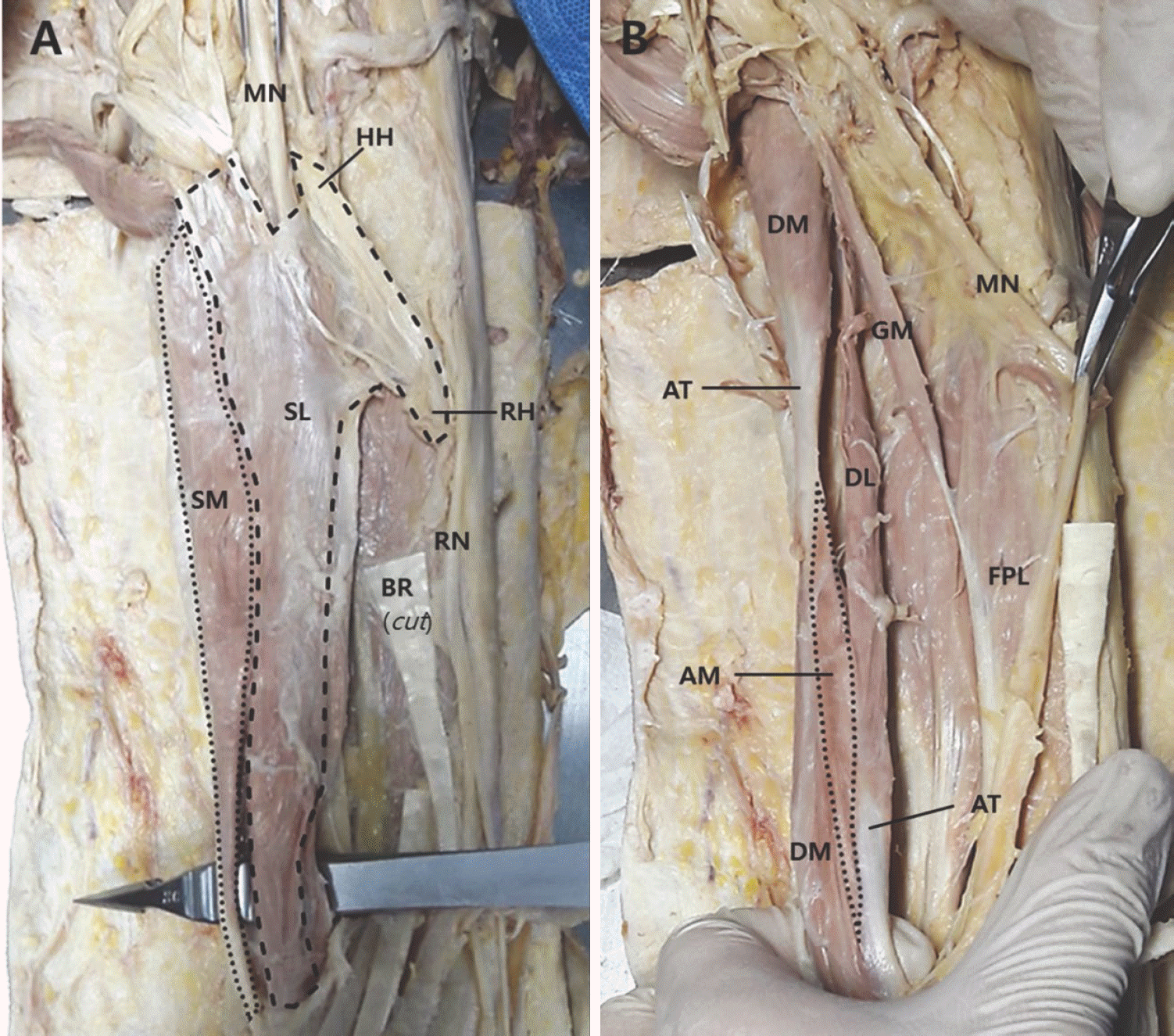Abstract
The flexor digitorum superficialis (FDS) muscle is located in the intermediate layer of the muscles in the anterior compartment of the forearm. Variable but individual variations have been reported in the FDS regarding the number of head and the origin, distribution and interconnections of muscle slip and insertion to finger. In this case, we report a concomitant complex variation in FDS which was observed in a cadaver during a routine dissection classes for the undergraduate medical students. It includes the variation which is the separation of the tendon of FDS into the super-ficial and deep layers, the structural variations in muscle slips and associated tendon variations, the finding of Gantzer' muscle leading to flexor pollicis longus muscle. These complex variations in FDS are very rare case and this report summarizes the related phylogenetic and embryological significance.
Go to : 
References
1. Richard LD, A . Wayne V, Adam WM. Gray's anatomy for students. 3th ed.Philadelphia: Elsevier/Churchill Livingstone;2013. p. 779.
2. Rodrigues V, Nayak SB, Rao MK, Vollala V, Somayaji N, Rao AS. Abnormal muscle in the anterior compartment of the forearm: a case report. Cases J. 2009; 2:9125–8.

3. Yesilada AK, Tatlıdede HS, Cakmak E. Anomalous large uniquemuscle belly of flexor digitorum superficialis and the absence of palmaris longus in the forearm. J Plast Reconstr Aesthet Surg. 2013; 66:137–9.
4. Han DK, Won HS, Liu HF, Chung IH, Kim IB. Separate muscle bundles of the flexor digitorum superficialis overlying the ulnar nerve. Folia Morphol. 2015; 74:434–8.

5. Pai MM, Nayak SR, Krishnamurthy A, Vadgaonkar R, Prabhu LV, Ranade AV, et al. The accessory heads of flexor pollicis longus and flexor digitorum profundus: incidence and morphology. Clin Anat. 2008; 21:252–8.

6. Takkallapalli A, Sanjay K, Krishnamurthy A, Dattatray D, Neelee J. A unique variation of flexor digitorum superficialis muscle and its clinical significance. J Life Sci. 2012; 4:39–43.
7. Lee SW, Lee JH, Lee HS. Double Gantzer's muscles by four muscle bellies and its clinical significance: A case report. Korea J Phys Anthropol. 2017; 30:67–70.

8. Oh CS, Chung IH, Koh KS. Anatomical study of the accessory head of the flexor pollicis longus and the anterior interosseous nerve in asians. Clin Anat. 2000; 13:434–8.

9. Nayak SR, Ramanathan L, Prabhu LV, Raju S. Additional flexor muscles of the forearm: case report and clinical significance. Singapore Med J. 2007; 48:e231–3.
10. Saghir N, Saghir R, Shahid S, Hachach-Haram N, Johal K, Sojitra N. A unilateral variation in the flexor digitorum superficialis with two distinct muscle bellies and associated tendons to the ring finger. J Plast Reconstr Aesthet Surg. 2016; 69:869–870.

11. Dixit SG, Kakar S. An uncommon variation of flexor digitorum superficialis indicis, a case report: Anatomical and clinical relevance. Clin Anat. 2010; 23:889–90.

12. Amrita G, Virendra K. Bilateral absence of flexor digitorum superficialis (FDS) tendon of the little finger: Clinical significance. J Clin Diagn Res. 2014; 8:135–6.
13. Elliot D, Khandwala AR, Kulkarni M. Anomalies of the flexor digitorum superficialis muscle. J Hand Surg Br. 1999; 24:570–4.
14. Tan JS, Oh L, Louis DS. Variations of the flexor digitorum superficialis as determined by an expanded clinical examination. J Hand Surg Am. 2009; 34:900–6.

15. Godwin Y, Wheble GA, Feig C. Assessment of the pres-ence of independent flexor digitorum superficialis function in the small fingers of professional string players: is this an example of natural selection? J Hand Surg Eur Vol. 2014; 39:93–100.

16. Puhaindran ME, Sebastin SJ, Lim AY, Xu WX, Chen YM. Absence of flexor digitorum superficialis tendon in the little finger is not associated with decreased grip strength. J Hand Surg Eur Vol. 2008; 33:205–7.
17. Methot J, Chinchalkar SJ, Richards RS. Contribution of the ulnar digits to grip strength. Can J Plast Surg. 2010; 18:e10–4.

Go to : 
 | Fig. 1.Cadaveric dissection showing left flexor digitorum superficialis. Superficial layer (A) and deep layer (B) of left flexor digitorum su-perficialis. SM, superficial-medial muscle slip; SL, superficial-lateral muscle slip; HH, humeral head of superficial-lateral muscle slip; RH, radial head of superficial-lateral muscle slip; MN, median nerve; RN, radial nerve; BR, brachioradialis (cut); DM, deep-medial muscle slip; DL, deep-lateral muscle slip; AM, additional muscle slip; AT, additional tendon; GM, Gantzer's muscle; FPL, flexor pollicis longus. |
Table 1.
Concomitant variations in flexor digitorum superficialis in this report.
| 1. Separation of superficial and deep layers of flexor digitorum superficialis |
| 2. Structural variation of muscle slips and associated tendon changes |
| A. Irregular merge between muscle slips B. Variation of origin in muscle slips |
| a. Weak radial origin of superficial lateral muscle slip∗∗ |
| b. Additional humeral origin of superficial lateral muscle |
| C. Additional muscle slip a. Additional muscle slip across two muscle slips |
| b. Tendons on both ends of additional muscle slip |
| 3. Flexor pollicis longus-related accessory muscle (Gantzer's muscle) |




 PDF
PDF ePub
ePub Citation
Citation Print
Print


 XML Download
XML Download